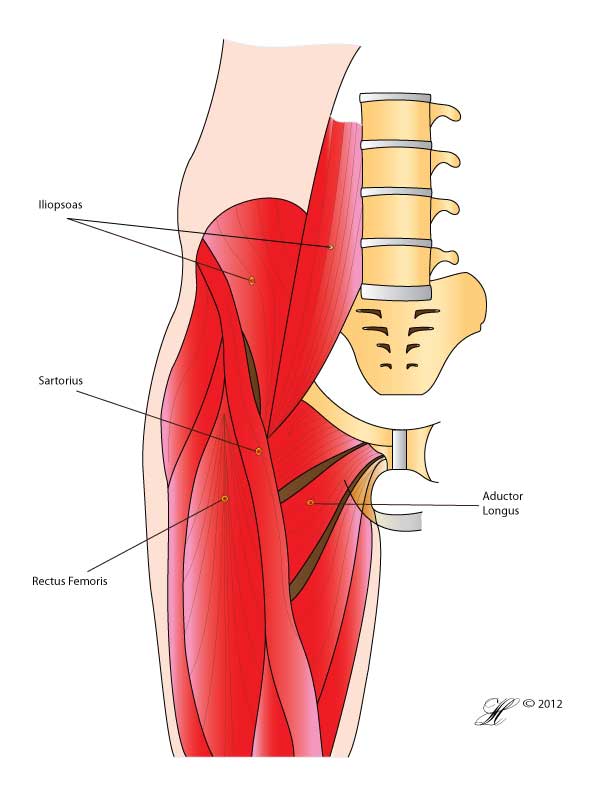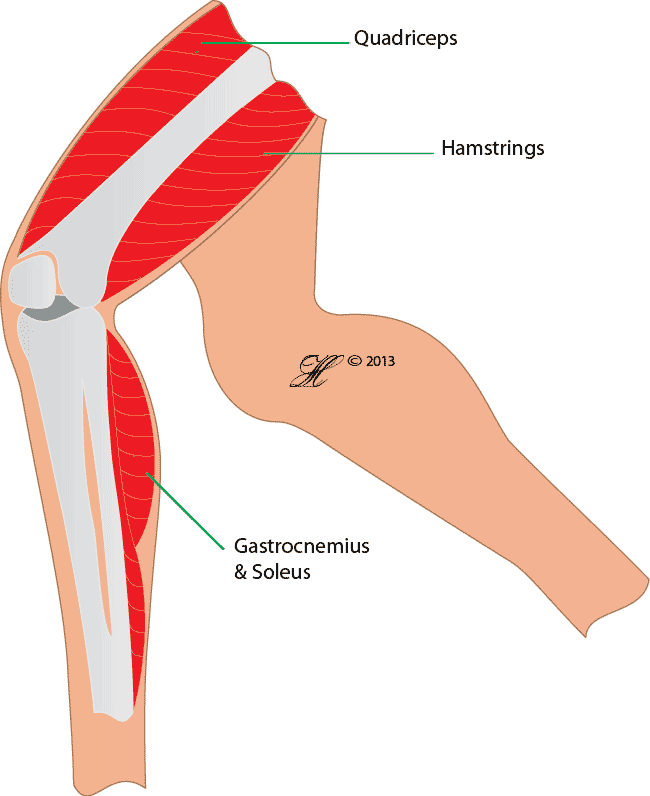A thigh strain is a tear to your quadriceps (thigh muscle).
It is a common injury sustained in sports like football that involve kicking or sprinting.
Your quadriceps are located at the front of the thigh and are responsible for straightening your knee. The Quadriceps muscle is made up of four muscles: Rectus Femoris, Vastus Lateralis, Vastus Intermedius and Vastus Medialis.
Any of these muscles can strain (or tear) but the most common is the Rectus femoris. This is because it is the only one of the four muscles which crosses both the hip and knee joints. This make it more susceptible to injury.

Symptoms
The severity of symptoms associated with thigh strains depends on the severity of the strain. Muscle strains are categorized into ‘grades 1-3’ which gives an indication of the degree of muscle injury. The grading system is as follows:
- Grade 1 strains involve minor tearing of muscle fibers with only minimal or no loss in strength. Pain is usually mild to moderate with no defect in the muscle tissue when examined by a doctor.
- Grade 2 strains involve more severe disruption to the muscle fibers with significant pain and loss of strength. A defect in the muscle tissue may sometimes be felt by your doctor.
- Grade 3 strains are a result of complete tearing of the muscle with associated severe pain and complete loss of strength. A defect in the muscle tissue can frequently be felt by your doctor on examination.
Recovery is longer with a high-grade injury, and the long-term outcome is potentially worse.
The following are general symptoms of thigh strains:
- At the time of injury, a popping or tearing sensation may be felt as the muscle is strained.
- Pain: Frequently a sharp pain is felt in the front of the thigh at the time of injury. Sometimes pain will not fully develop until the end of a game, practice, or sporting activity. Location of pain can be anywhere along the quadriceps muscle, (which runs along the front of the thigh), but is classically felt nearer the knee than the hip.
- Weakness: The strained muscle may feel weak. This can lead to a sensation of loosing power in the leg.
- Swelling: There may be swelling over the site of the thigh strain. Bruising may also be present.

Causes
A muscle strain occurs most commonly when a muscle is stretched whilst it is contracting. This type of contraction is termed ‘eccentric contraction’. If you think about placing a heavy object on the table, your biceps are contracting whilst lengthening. This allows controlled movement as you place the object. The same type of muscle contraction occurs in the knee whilst you are running, kicking or jumping. During these actions, the muscle can stretch too far whilst it is contracting and lead to a muscle strain.
Thigh strains often occur during sprinting, jumping, hopping or kicking activities. This is particularly so during explosive acceleration (e.g. sprinting), when a footballer performs a long kick or following an inadequate warm-up. If a muscle is tight due to overuse or not warming up properly, then this can lead to straining the muscle during sports or activities that would normally not lead to an injury.
Another cause of thigh strain is repetitive trauma. Distance runners are susceptible to thigh strains due to the stress exerted on the quadriceps muscles. The frequency and duration of their running means that the thigh muscles can become progressively tight and eventually this can lead to a muscle strain.
Risk Factors
The following are risk factors for hip strains:
- Not warming up correctly: If you do not warm up the quadriceps muscles prior to playing sports which involve large knee or hip movements, there is an increased risk of suffering a thigh strain. Prior to exercise, a sport specific warm up should be performed including gentle stretching, sub-maximal cardio workout and range of motion exercises.
- Previous injury: A thigh strain that has either not fully healed or left residual scar tissue may predispose to a further thigh strain in the future
- Sports activities which hold a risk of thigh strains include football (Australian rules), soccer, rugby, basketball, and long distance running or sprinting.
Investigations
Thigh strains are initially diagnosed through a thorough history and examination. It is important to tell the doctor when the pain was first felt and the exact movement that was being performed at that time. Once a history of the injury has been taken, the doctor will examine the thigh, knee and hip. They may palpate (apply pressure) in different areas of the thigh looking for pain in order to see which part of the muscle might be affected. They may also ask you to perform various movements of the knee and hip to determine the extent of the injury.
Usually strains can be diagnosed in a clinical setting without the need for further investigations. Sometimes if it is unclear as to whether the problem is a thigh strain or a stress fracture, and in this case an X-ray may be considered. Occasionally in order to determine the extent of the strain, an ultrasound or MRI may be performed which may help in defining the muscle strain. This is rarely necessary however.
Complications
If a thigh strain is not properly treated, or a return to sport is made before the injury has enough time to recover, the thigh strain can become chronic. This means that there is ongoing pain in the thigh area requiring prolonged rehabilitation.
Thigh strains may leave the affected muscle slightly weaker or slightly tighter than prior to the injury. This can predispose to straining the same area again in the future. It is important to complete the full course of treatment and rehabilitation laid out by your doctor or physiotherapist in order to minimise this risk.
Symptomatic fibrosis (or scarring) occurs less frequently. In some athletes, how-ever, a severe muscle strain injury will result in a painful area of scarring or fibrosis. Treatment for this complication should involve physical therapy with stretching and perhaps the use of modalities such as ultrasound and deep-tissue massage. Very occasionally, surgical intervention is required to remove the area of scar tissue.
Treatment
Thigh strains generally recover well. The goals of treatment are to minimise the pain, allow the muscle to heal and then restore normal range of motion and strength. This treatment follows a stepwise process:
Initial treatment – rest and recovery
The first 24–72 h after a quadriceps strain should be focused on the ‘RICE’ principles: rest, ice, compression and elevation. Your doctor may also prescribe some anti-inflammatory medication or pain relief medication. The use of crutches when walking may be necessary to protect the thigh muscles from further damage and to hasten the healing process. If the thigh strain is minor, this may be all the treatment that is required. For more serious strains, a physiotherapist may be required for rehabilitation of the area.
Ignoring symptoms, or adopting a ‘no pain, no gain’ attitude is likely to lead to the problem becoming chronic (ongoing). Immediate, appropriate treatment in patients with a quadriceps strain is essential to ensure a speedy recovery.
Rehabilitation – passive and active range of motion exercises
This phase usually begins approximately 3–5 days after the initial injury depending on its severity. A graduated flexibility and strengthening program guided by a physiotherapist may be necessary for more severe thigh strains. Careful assessment by the physiotherapist to determine which factors have contributed to the development of the condition, with subsequent correction of these factors is also important to ensure an optimal outcome. The rehabilitation will involve moving the knee, first passively and then actively. This means initially, the knee is moved either by someone else or using your arms to assist the movement such that the injured muscle does not work during these movements. Following this knee and hip movements are performed using the muscles that have been injured.
Final stages – strength training
Initially exercises will be given that isolate and strengthen the injured muscle. Once the muscle regains its strength, a graduated return to running or sport specific activities is the final stage of rehabilitation and is required to fully recondition the thigh muscles. This should include the implementation of progressive acceleration and deceleration running drills before returning to sport.
Once there is full range of motion of the hip and knee, full strength equal or greater than the uninjured thigh, and you are able perform all of the fundamental skills of the required sport pain free, you are ready to return to sport.
Seeking Advice
Your Family Doctor (GP)
Your Family Doctor will be able to diagnose and help treat your problem. He or she will be able to
- tell you about your problem
- advise you of the best treatment methods
- prescribe you medications
- and if necessary, refer you to Specialists (Consultants) for further treatment
Prevention
Prevention of hip strains requires a focus on good flexibility and strength of the thigh muscles. By following a few simple rules, the likelihood of thigh strains can be reduced:
- Warm up: A warm up should be performed prior to sport which should involve some simple sport specific drills and range of motion exercises (eg. leg swings, jogging, jumping, direction changes whilst jogging, if playing soccer/football)
- Strengthening: Make sure the muscles of the thigh are well conditioned through strengthening programs

